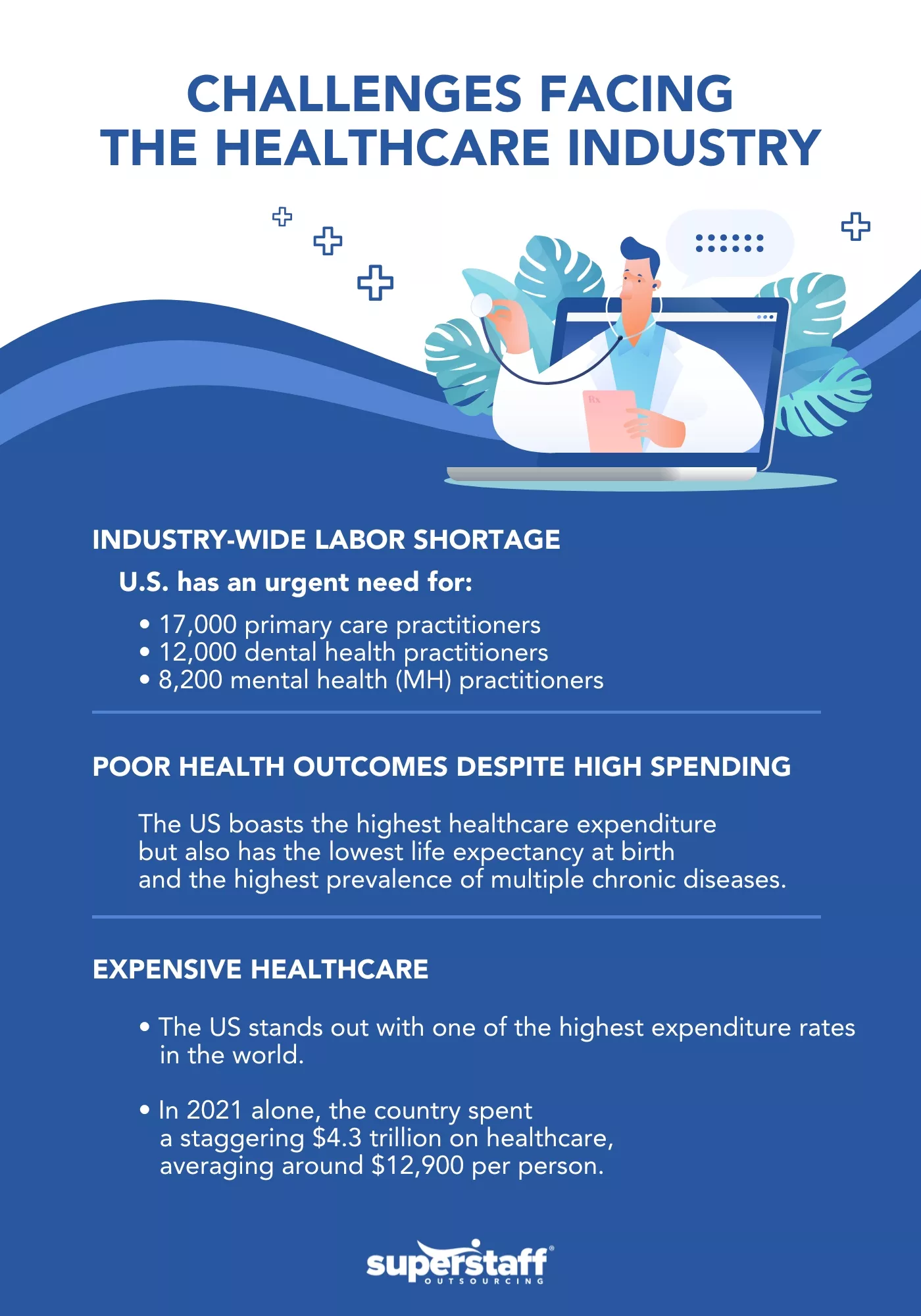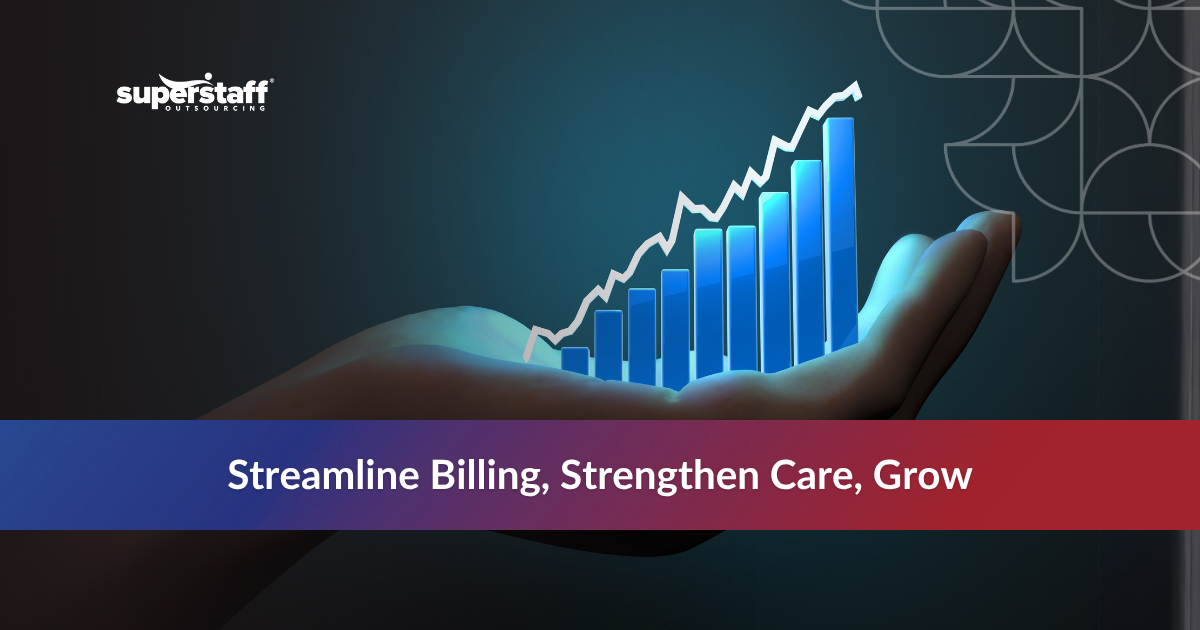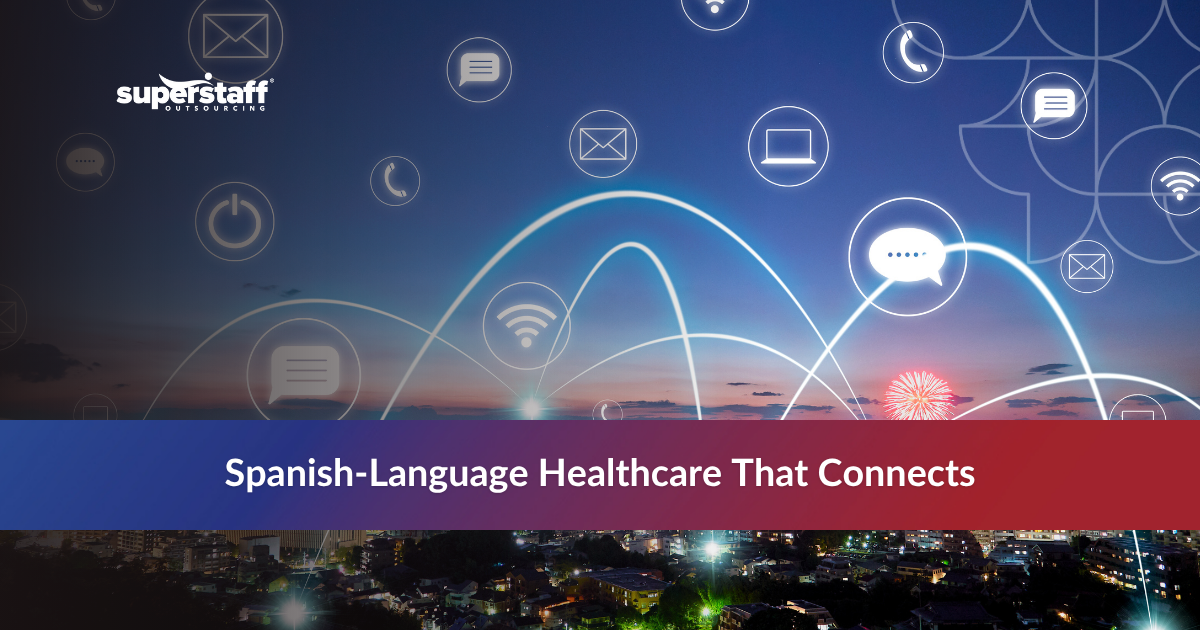
The global health crisis has reshaped healthcare as we know it.
From brain implant technology and AI to gene therapy and telemedicine, healthcare tech continues to revolutionize patient care while at the same time improving public health value-based care and enhancing the operational efficiency of hospitals and health institutions.
What other healthcare tech trends drive the industry, and how will they impact healthcare providers, patients, and the healthcare ecosystem? Join us as we delve into the fascinating world of health tech and discover how these trends are transforming the industry’s future.
State of Healthcare in the U.S.
While there are significant breakthroughs in health technology in the digital age, challenges hindering growth still plague the sector: a labor shortage, escalating costs, and dismal health outcomes. Let’s look at the issues we must address in the post-pandemic landscape.

Industry-Wide Labor Shortage
The US is facing a critical staffing shortage, leading to significant challenges within the health sector. Recent data from the Health Resources & Services Administration (HRSA) highlights the urgent need for health workers – particularly 17,000 primary care practitioners, 12,000 dental health practitioners, and 8,200 mental health (MH) practitioners nationwide.
Meanwhile, as the population grows and ages, the demand for healthcare services continues to soar, fuelling the shortage further.
Poor Health Outcomes Despite High Spending
The US boasts the highest healthcare expenditure among high-income countries. Yet, a recent report from The Commonwealth Fund reveals a troubling paradox: the nation also has the lowest life expectancy at birth and the highest prevalence of multiple chronic diseases, raising important questions about the effectiveness of the American healthcare system.
Expensive Healthcare
When it comes to healthcare, the US stands out with one of the highest expenditure rates in the world. In 2021 alone, the country spent a staggering $4.3 trillion on healthcare, averaging around $12,900 per person – significantly higher compared to other wealthy nations, where healthcare costs are only about half as much.
Addressing the cost conundrum in American healthcare requires innovative solutions. By leveraging technology, fostering collaboration, and implementing transformative strategies, the healthcare sector can overcome these challenges and pave the way for a more accessible, cost-effective, and patient-centric future.
7 Emerging Healthcare Tech Trends
Let’s take a closer look at the trends in healthcare tech transforming the industry.
#1 Brain Implant Technology
Elon Musk, the visionary entrepreneur behind groundbreaking companies such as Tesla, SpaceX, and ChatGPT, has set his sights on yet another frontier to conquer: healthcare.
His brain-implant startup, Neuralink, marked a significant milestone with approval from the US Food and Drug Administration (FDA) for its first-in-human clinical trial – a crucial step toward realizing its vision of developing a device capable of directly interfacing with the human brain.
In a tweet, Neuralink expressed excitement over the FDA approval, highlighting its potential to help countless individuals. While the specifics of the study remain undisclosed, Neuralink assured the public that more information will be available soon.
This cutting-edge technology is a promising frontier in neuroscience that offers endless possibilities in our quest to understand the intricacies of the human brain. By implanting tiny, flexible threads into the brain, Neuralink’s device can precisely monitor brain activity and stimulate specific regions – a game-changer for people with conditions like epilepsy, Parkinson’s disease, paralysis, and even mental issues.
However, as with revolutionary technology, makers should address ethical considerations and privacy concerns. Neuralink’s critical milestone is facing scrutiny over reports about their questionable animal experimentation that resulted in more animal deaths than necessary.
#2 AI Killer Drug
In recent years, the rapid advancement of artificial intelligence (AI) brought about a revolution across industries, and healthcare is no exception. The integration of AI in the sector can significantly transform health systems, diagnostics, and medical research.
While it’s already an invaluable tool that plays a considerable part in healthcare – from improving diagnosis accuracy to revolutionizing treatment plans – scientists have recently found a new, more cutting-edge purpose for AI.
In a breakthrough development, scientists have harnessed the power of AI to identify a potential antibiotic called abaucin that could combat the deadly drug-resistant bacterium Acinetobacter baumannii, which poses a significant threat to public health. This remarkable feat holds the promise of significantly reducing the time and effort required to develop new drugs while highlighting AI’s potential to revolutionize other fields.
#3 Gene Therapy
The field of medicine has witnessed extraordinary advancements in the last decade, and one area that holds great promise is gene therapy. This revolutionary approach aims to cure genetic diseases by replacing defective genes.
In a recent groundbreaking study, scientists are discovering how it can help with age-related hearing loss. Researchers successfully used adeno-associated virus vectors for aged mice with genetic hearing loss, resulting in their hearing restoration. The development shows the potential of gene therapy to reverse the effects of genetic hearing loss, even in older adults.
This model’s successful application of gene therapy offers hope for addressing genetic hearing loss in older adults. Although more studies are needed, these findings provide a solid foundation for future studies and clinical trials to explore gene therapies for treating genetic hearing loss in aging individuals.
#4 Remote Healthcare and Telemedicine
Telemedicine and remote care have emerged as significant game-changers, revolutionizing how we access medical services, enhancing efficiency, and improving patient outcomes in the digital age.
These trends have opened up new possibilities for healthcare, bridging the gap between patients and providers. By leveraging digital technologies, patients can seamlessly consult with healthcare professionals, receive diagnoses, obtain prescriptions, and even monitor chronic conditions from their homes – ultimately transforming the healthcare landscape and making quality care more readily available to all.
As the global telemedicine market continues to expand, with estimates projecting its value to reach nearly $460 billion within the next decade, it is clear that telehealth is not just a passing trend but the future of healthcare itself.
#5 Virtual Reality for Healthcare
Cutting-edge virtual and augmented reality technology such as Metaverse have gone beyond the realm of gaming and now holds immense promise for transforming all industries.
In healthcare, practitioners are discovering innovative ways to leverage virtual reality (VR) to enhance treatments and improve patient outcomes. VR is revolutionizing the healthcare landscape, from surgery and pain management to physical and cognitive rehabilitation and psychiatry.
In the wake of the global pandemic, safety became a paramount concern in healthcare. Virtual healthcare offered a solution that minimized the risk of exposure to infectious diseases. By enabling remote consultations, telemedicine allowed patients to receive medical advice and treatment from the comfort and safety of their homes.
But the healthcare VR trend outlived the pandemic, ensuring that quality healthcare reaches even the most underserved areas. It continues to break down geographical barriers and expand access to medical expertise for improved patient outcomes.
VR applications in MH and rehabilitation also enable patients to receive timely and effective interventions regardless of physical location. Moreover, VR physical therapies opened doors to quality care for individuals who may have previously faced challenges accessing specialized treatment.
VR also enables surgeons to practice complex procedures in a simulated environment, leading to improved precision, reduced surgical time, and enhanced patient safety. Additionally, VR experiences, such as immersive games or environments, have been shown to reduce patients’ pain perception. Redirecting the brain’s attention provides a holistic, non-medical approach to pain management.
The potential for VR to revolutionize healthcare grows as technology continues to advance. By embracing these transformative tools, we can create a future where healthcare is more accessible, convenient, and patient-centered.
#6 Digital Twin Technology
Essentially, a digital twin is a virtual counterpart of a physical entity that closely mimics its behavior, characteristics, and responses to real-world changes. Real-time data and advanced algorithms offer a dynamic representation of the object or system, enabling virtual simulations and analysis. A digital twin allows us to gain valuable insights, optimize performance, and make informed decisions without directly impacting the object.
Much like digital twins replicate physical objects, the health technology company Philips envisions the creation of a “digital patient” – a comprehensive digital model of a human body representing various measurements and characteristics. While the complete realization of a digital patient is still a work in progress, Philips has made significant strides in a specific area of the body: the heart. Their clinical application, HeartModel, generates a personalized 3D view of a patient’s heart using 2D ultrasound images, paving the way for a future where virtual hearts could potentially save real lives.
As healthcare providers leverage data analytics, machine learning, and artificial intelligence, the power of digital twins will continue to reshape healthcare.
#7 Nearshore and Offshore Specialty Healthcare BPO Services
COVID-19 has accelerated the transformation of the health industry, introducing a new era of fast and convenient access to healthcare services. Patients have come to expect the convenience and efficiency of virtual consultations and remote patient monitoring.
The development makes it imperative for providers to adapt and integrate those advancements into their healthcare delivery models. But on top of that, there is also growing demand for preventive care to reduce the prevalence of chronic conditions as the baby boomer generation reaches retirement age.
Delivering quality healthcare in the face of changing demands poses many challenges for healthcare providers, from managing the complexities of their daily operations to navigating recruitment challenges and the lack of technological capabilities. These industry changes can be overwhelming for healthcare organizations to handle alone. Providers are turning to specialty healthcare outsourcing as a strategic solution to overcome these challenges.
Long before COVID-19 upended the health sector, outsourcing had already been instrumental to the success of healthcare facilities as it helped drive down costs, enhance their productivity, and foster scalability and flexibility.
With their deep understanding of the unique challenges faced by healthcare facilities, BPOs tailor their solutions to clients’ specific needs and goals. They leverage their industry expertise, skilled workforce, and cutting-edge technology to boost productivity, elevate patient care, improve health outcomes, and help their clients keep pace with the evolving industry.
Read more: Answering 13 Frequently Asked Questions About Specialty Healthcare Outsourcing
What Are the Different BPO Services?
- Medical Transcription
Medical transcription involves converting voice-recorded medical dictations, such as physician notes, patient histories, and diagnostic reports, into written format.
- Medical Billing and Coding
BPO providers accurately assign appropriate codes to diagnoses, procedures, and treatments documented in patient medical records. This ensures compliance with coding guidelines and improves reimbursement and billing turnover rates.
- Insurance Claim Processing
BPOs handle the complete claims submission process, including preparing and submitting accurate claims to insurance companies on behalf of healthcare facilities. They also manage claims throughout the reimbursement cycle, including following up on claim status, addressing denials, and appeals management.
- Medical Call Center Services
Medical call centers deal with many healthcare-related touchpoints, from providing patient support to scheduling appointments. They also handle patient registration and triage.
- Other Non-Clinical Functions
- Programming and Development
- Recruitment
- Technical Support
- Enterprise Resource Planning (ERP)
- Supply Chain Management
- Accounting
- Fraud Prevention
- Content Services
Outsourcing gives hospitals and health institutions access to advanced expertise and industry best practices. Healthcare BPOs have deep domain knowledge and stay up-to-date with the latest developments, enabling providers to benefit from their specialized skills and experience. Working with third-party organizations also allows them to scale their workforce and operations up or down based on fluctuating demand.
Keep Pace With the Latest Healthcare Tech Trends Making Waves in the Industry
Don’t fall behind in the ever-changing healthcare industry.
Embrace outsourcing to access specialized expertise and cutting-edge technologies, and stay ahead of the latest industry trends. Reach out to SuperStaff today to explore your outsourcing options today and position your healthcare business for success.







